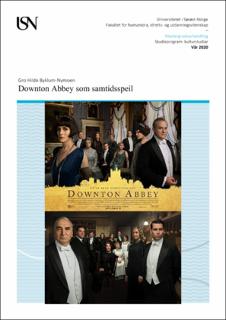| dc.contributor.author | Byklum-Nymoen, Gro Hilde | |
| dc.date.accessioned | 2020-12-30T11:00:39Z | |
| dc.date.available | 2020-12-30T11:00:39Z | |
| dc.date.issued | 2020 | |
| dc.identifier.uri | https://hdl.handle.net/11250/2721108 | |
| dc.description.abstract | Denne oppgaven ser på deler av Storbritannias historie knyttet til serien Downton Abbey og ser på hvordan den er avbildet i Julian Fellowes sitt periodestykke. Oppgaven gir en kort oppsummering av den historiske, politiske og sosiale bakgrunnen som Downton Abbey er basert på. Den beskriver kompleksiteten i samfunnet under Edvard Vll og sammenligner det med viktige scener i TV-serien, og hvordan enkelte karakterer brukes for å representere typiske trekk for den edvardianske perioden eller endringer i samfunnet
Oppgaven drøfter også hvordan historien i TV-serien gjenspeiler periodens problemer, og hvordan karakterene utvikler seg for å skildre et skifte i politikk eller en historisk hendelse. Oppgaven ser på forholdet mellom «upstairs» og «downstairs», og ser på hvordan klasseskillet i Storbritannia startet og hvordan klasseskillet i den edvardianske perioden var. Den beskriver noen av hovedpersonene og diskuterer hvordan deres del i serien bidrar til den generelle representasjonen av perioden, samt hvordan deres karakter symboliserer en sosial gruppe eller hvordan de blir brukt til å skildre et sosialt problem. Oppgaven ser også på tema serien Downton Abbey tar opp, og om de er relevante i dag. Oppgaven tar også for seg samfunnet i Storbritannia i perioden TV-serien ble vist og ser på den økonomiske krisen Storbritannia da sto ovenfor. Oppgaven ser også på klassesystemets utvikling fra den edvardianske perioden til dagens samfunn, og diskuterer hvorvidt klassesystemet fortsatt står sterkt i det Britiske samfunnet. Viktigst diskuterer oppgaven om Downton Abbey kan sees som et samtidsspeil til tiden den er satt i, og om vi fortsatt kan se rester og eller likheter til samfunnsmodellen vi ser i serien Downton Abbey i årene serien ble sendt og frem til i dag | en_US |
| dc.description.abstract | This thesis looks at some of Britain’s history connected to the TV-show Downton Abbey, and looks at how it is depicted in Julian Fellowes historical drama. The thesis gives a brief summary of the historical, political and social background in which Downton Abbey is set. It describes the complexity of the society during the reign of Edward VII and compares it with important scenes in the series, and looks at how certain characters are used to represent typical Edwardian traits or changes in society.
The thesis also deliberates how the history of which Downton Abbey is set can reflect the eras problems, and how the characters evolve to show a change in politics or an historical event. The thesis looks at the relationship between “upstairs” and “downstairs”, and how the British class system started and showed itself in the Edwardian era. It describes some of the main characters and discusses how their role contributes to the general representation of the era, and also how their character symbolizes a social group or how they are used to show a social problem in society. The thesis also writes about different topics dealt with by the TV-series and sees if these are still relevant today. The thesis also deals with British society in the time that Downton Abbey aired and writes about the financial crisis in which Britain faced at that time. The thesis also looks at how the class system has changed from the Edwardian era to now, and discusses if the British class system is as rigid as it once was. Most importantly the thesis discusses if Downton Abbey mirrors the time in which it was aired, and if we can link it to today`s society | en_US |
| dc.language.iso | nob | en_US |
| dc.publisher | Universitetet i Sørøst-Norge | en_US |
| dc.title | Downton Abbey som samtidsspeil | en_US |
| dc.type | Master thesis | en_US |
| dc.description.version | publishedVersion | en_US |
| dc.rights.holder | Copyright The Author | en_US |
| dc.subject.nsi | VDP::Humaniora: 000::Kulturvitenskap: 060 | en_US |
